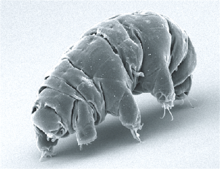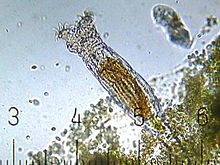User:Joeadunlap/Evolution of Cryptobiosis
Cryptobiosis, which can occur through a variety of mechanisms in response to extreme conditions such as desiccation, low oxygen levels, toxicity, extreme temperatures, and solute concentrations has been displayed amongst diverse organisms from tardigrades to angiosperms. Evolution of these mechanisms and linkages in the genome have been researched yet is still an ongoing quest. Understanding of how cryptobiosis developed could lead to the application of this knowledge which could include creating shelf stable vaccinations, leads in the field of astrobiology, and uncovering more on the evolutionary history of Phylum Tardigrada.
Introduction[edit]

Organisms that display cryptobiotic abilities are often divided between those that utilize these mechanisms only during a certain life stage or undergo cryptobiosis throughout an organism's life. [1] Many arthropods, bacteria, fungi, and plants fall under the first category while tardigrades, rotifers, protozoans, and nematodes fall under the latter. Anhydrobiosis, the form of cryptobiosis that occurs in response to desiccation, is one of the more widespread mechanisms across kingdoms: potentially having evolved before the divergence of kingdoms. [2] Phylogenetic analyses and comparative data both suggest that tolerance is an ancestral character in land plants, either the mature vegetative state or the spore, as well as in bdelloid rotifers. In addition, late embryogenesis abundant (LEA) genes which are associated with the beginning stages of desiccation tolerance in seeds, have also been found in mosses, bacteria, nematodes, yeasts, and algae. [2]
The Evolutionary Costs of Tolerance[edit]

Despite cryptobiotic abilities being widespread amongst various kingdoms and phylums, they are rare. Investing resources to tolerance of a stressful environment can be costly and constraining on growth and the ability to compete.[2] Desiccation tolerance is thought to be a primitive characteristic and if lineages transitioned to an environment where water was more readily available, genes related to tolerance would not be expressed and selection would favor those that did not display tolerance. Furthermore, in areas of increasing water availability, organisms that are desiccation sensitive would outcompete desiccation tolerant organisms.[2] Growth is also impacted by organisms with cryptobiotic abilities; cryptobiotic adult animals usually curl up their entire body when in a cryptobiotic state. In tardigrade species Millnesium tardigradum, the cytoskeleton is remodeled during anhydrobiosis through the down regulation of beta actin and beta tublin and the upregulation of cofilin.[3] Due to this, a smaller size is favored and most cryptobiotic animals are less than five millimeters in length.[2]
Whether an organism is holo-cryptobiotic, utilizing cryptobiosis throughout their life history, or only cryptobiotic at certain stages of life, the process is quite disruptive. To undergo cryptobiosis, metabolism is completely halted. This implies that growth and reproduction will be as well which ultimately impacts fitness. The process is a temporal escape from hostile conditions rather than a spatial one which is often carried out through migration.[4] Disruption is intensified in microhabitats where frequent changes in desiccation, pH, or temperature occur. On the contrary, some organisms such as the Bdelloid rotifer are dependent on anhydrobiosis for a more robust life cycle. [5] Reproduction was founded to be enhanced during the post recovery period of Adineta ricciae, a species that lives in an environment of widely variable water availability. In other cryptobiotic species, fecundity is thought to be negatively impacted by periods of metabolic depression but has lead to some adaptations such as some tardigrade species being parthenogenic and having particular breeding seasons.[4]
Evolution of Cryptobiosis in Phylum Tardigrada[edit]

Despite being well known as an organism that undergoes cryptobiosis, the knowledge of tardigrades evolutionary history, including how cryptobiosis evolved in this phylum is lacking. [1] One possible scenario is that cryptobiosis first evolved in a marine ancestor that lived in tidal habitats as selection would have favored individuals that were able to respond to repeated desiccation.[1] Certain genus of tardigrades such as Echiniscoides and Archechiniscus that inhabit littoral marine environments have displayed tolerance to desiccation while purely marine species have not. [1]
Another possible way cryptobiosis could have evolved is horizontal gene transfer. The genome of Hypsibius dujardini has been investigated for potential evidence of horizontal gene transfer with initial studies reporting as high as 17% of the genome originating from horizontal gene transfer.[6] This was debunked by a later study after finding that contamination contributed to the higher percentage and that roughly 1-2% of Hypsibius dujardini's genome can be attributed to HGT.[6]
Comparison between multiple genus of tardigrades including the marine tidal heterotardigrade Echiniscoides sigismundi and eutardigrades Ramazzottius varieornatus and Hypsibius exemplaris failed to indicate a source of where cryptobiosis could have arose in the phylum. What were thought to be "tardigrade unique proteins" (CAH, SAHS, MAHS, and RvLEAM) were not found to be expressed in the heterotardigrade lineage despite Echiniscoides sigismundi having a reputation of being a strong cryptobiont. [7] It is likely that there has been divergence amongst tardigrade evolutionary lineages in regards to expression of stress response genes. [7]
In response to desiccation, M. tardigradum incorporates patterns of differential expression of transcripts which include the down-regulation of proteins involved in DNA replication, translation, and protein degradation. Also involved is the up-regulation of heat shock proteins Hsp27 and Hsp30c and UBB which is involved in DNA repair. [3] It is likely that a combination of several mechanisms is involved in undergoing cryptobiosis and recovering afterwards in phylum Tardigrada. These components as well as those involved in cytoskeleton rearrangement are highly conserved and are essential to overall metabolism of this organism[3]. They have also been described in a variety of animals that undergo metabolic depression in response to intense environmental stressors.[3]
Evolution of Cryptobiosis in Plants[edit]

Staple crops such as maize, corn, rice, and wheat which are all a part of the Poacae family are all prone to severe weather events, including drought. However, their seeds are tolerant to desiccation and can be dried to a water content as low as 1-5% without becoming unviable.[8] Likewise, there are approximately 135 angiosperms, referred to as resurrection plants, that display cryptobiotic properties in the form of anhydrobiosis.[8] In angiosperms, tolerance can either occur in the seed stage of their life history or during the vegetative state in which desiccation tolerant tissues occur.[8] It has been hypothesized that tolerance to desiccation evolved as life transitioned from an aquatic environment to a terrestrial environment where access to water became increasingly uncertain.[1] As more complex ecosystems developed and more efficient mechanisms of water retention evolved, desiccation tolerance lost some of its competitive viability due to constraints on growth and reproduction.[8] However, desiccation tolerance has been retained in many plant species' seeds and has been essential for plants colonizing novel environments. It is possible that vegetative desiccation tolerance has reappeared in at least thirteen separate lineages and has lead to the evolution of modern resurrection plants.[8] This has lead to the hypothesis that vegetative tolerance was derived from the genetic information involved in seed desiccation tolerance.[8]
Carbon gain and water content have been found to be reflective of when certain plants such as Xerophyta viscosa are undergoing metabolic stress.[8] Another indicator is genomic clustering of anhydrobiosis-related gene islands (ARIds) which are areas where transcripts can accumulate during desiccation.[8] LEA proteins have also been found to be important actors in stress tolerance.[9] They are typically involved in plant embryo development and maturation but also have been found in pollen, fungal spores, yeast cells, and embryos of crustaceans.[8] LEA proteins have been implicated to play a role in the response to high salinity, freezing, and desiccation tolerance. They also can have roles as antioxidants and as protein and membrane stabilizers during periods of abiotic stress.[9] Desiccation seems to be intertwined with the LEA proteins structural plasticity as they become more complexly folded when exposed to water stress. When fully hydrated, they are lacking in secondary structure.[9]
An important aspect to note in plant cryptobiosis is the preservation of photosynthetic machinery. During the period of metabolic depression, the machinery is inactivated to prevent the interference of the energy transfer from chlorophyll molecules that could be redirected to oxygen molecules and cause ROS.[10] During anhydrobiosis in plants, it is typical for photosynthetic machinery to remain in a passive state until conditions are suitable to resume activity.
References[edit]
- ^ a b c d e Jönsson, K. Ingemar; Järemo, Johannes (2003). "A model on the evolution of cryptobiosis". Annales Zoologici Fennici. 40 (4): 331–340. ISSN 0003-455X.
- ^ a b c d e Alpert, P. (2006-05-01). "Constraints of tolerance: why are desiccation-tolerant organisms so small or rare?". Journal of Experimental Biology. 209 (9): 1575–1584. doi:10.1242/jeb.02179. ISSN 0022-0949.
- ^ a b c d Wang, Chong; Grohme, Markus A.; Mali, Brahim; Schill, Ralph O.; Frohme, Marcus (2014-03-20). "Towards Decrypting Cryptobiosis—Analyzing Anhydrobiosis in the Tardigrade Milnesium tardigradum Using Transcriptome Sequencing". PLoS ONE. 9 (3): e92663. doi:10.1371/journal.pone.0092663. ISSN 1932-6203.
{{cite journal}}: CS1 maint: unflagged free DOI (link) - ^ a b Jonsson, K. I. (2005-11-01). "The Evolution of Life Histories in Holo-anhydrobiotic Animals: A First Approach". Integrative and Comparative Biology. 45 (5): 764–770. doi:10.1093/icb/45.5.764. ISSN 1540-7063.
- ^ Ricci, Claudia; Caprioli, Manuela; Fontaneto, Diego (2007). "Stress and fitness in parthenogens: is dormancy a key feature for bdelloid rotifers?". BMC Evolutionary Biology. 7 (Suppl 2): S9. doi:10.1186/1471-2148-7-s2-s9. ISSN 1471-2148.
{{cite journal}}: CS1 maint: unflagged free DOI (link) - ^ a b Koutsovoulos, Georgios; Kumar, Sujai; Laetsch, Dominik R.; Stevens, Lewis; Daub, Jennifer; Conlon, Claire; Maroon, Habib; Thomas, Fran; Aboobaker, Aziz A.; Blaxter, Mark (2016-05-03). "No evidence for extensive horizontal gene transfer in the genome of the tardigrade Hypsibius dujardini". Proceedings of the National Academy of Sciences. 113 (18): 5053–5058. doi:10.1073/pnas.1600338113. ISSN 0027-8424.
- ^ a b Kamilari, Maria; Jørgensen, Aslak; Schiøtt, Morten; Møbjerg, Nadja (2019-12). "Comparative transcriptomics suggest unique molecular adaptations within tardigrade lineages". BMC Genomics. 20 (1): 607. doi:10.1186/s12864-019-5912-x. ISSN 1471-2164.
{{cite journal}}: Check date values in:|date=(help)CS1 maint: unflagged free DOI (link) - ^ a b c d e f g h i W.M., Costa, Maria Cecília D. Artur, Mariana A.S. Maia, Julio Jonkheer, Eef Derks, Martijn F.L. Nijveen, Harm Williams, Brett Mundree, Sagadevan G. Jiménez-Gómez, José M. Hesselink, Thamara Schijlen, Elio G.W.M. Ligterink, Wilco Oliver, Melvin J. Farrant, Jill M. Hilhorst, Henk (2017-03-27). A footprint of desiccation tolerance in the genome of Xerophyta viscosa. OCLC 1130207530.
{{cite book}}: CS1 maint: multiple names: authors list (link) - ^ a b c Tunnacliffe, Alan; Wise, Michael J. (2007-05-04). "The continuing conundrum of the LEA proteins". Naturwissenschaften. 94 (10): 791–812. doi:10.1007/s00114-007-0254-y. ISSN 0028-1042.
- ^ Challabathula, Dinakar; Puthur, Jos T.; Bartels, Dorothea (2015-09-16). "Surviving metabolic arrest: photosynthesis during desiccation and rehydration in resurrection plants". Annals of the New York Academy of Sciences. 1365 (1): 89–99. doi:10.1111/nyas.12884. ISSN 0077-8923.
